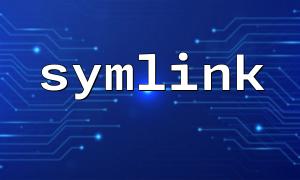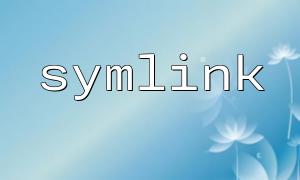The basic syntax of the symlink() function is as follows:
<span><span><span class="hljs-keyword">bool</span></span><span> </span><span><span class="hljs-title function_ invoke__">symlink</span></span><span>(</span><span><span class="hljs-keyword">string</span></span><span> </span><span><span class="hljs-variable">$target</span></span><span>, </span><span><span class="hljs-keyword">string</span></span><span> </span><span><span class="hljs-variable">$link</span></span><span>)</span></span>$target: The path to the target file or directory.
$link: The path of the symbolic link.
If the function succeeds, it returns true; otherwise, it returns false and generates an error message.
When discussing symlink(), it's important to first understand the basic definitions of these two types of paths.
Absolute path: A full path starting from the root directory of the file system. For example: /var/www/html/index.php.
Relative path: A path relative to the current working directory. For example: ./index.php or ../images/logo.png.
When using an absolute path as the target, symlink() directly references the full path of the file or directory, unaffected by the current working directory (the location of the running script). The created symbolic link will always point to that absolute path, so even if accessed from different directories, it will correctly locate the target.
Example:
<span><span><span class="hljs-comment">// Target file as an absolute path</span></span>
</span><span><span class="hljs-variable">$target</span></span> = <span class="hljs-string">'/var/www/html/index.php'</span>;
</span><span><span class="hljs-variable">$link</span></span> = <span class="hljs-string">'/var/www/html/link_to_index.php'</span>;
<p></span>if (symlink($target, $link)) {<br>
echo "Symbolic link created successfully!";<br>
} else {<br>
echo "Failed to create symbolic link!";<br>
}<br>
In this example, no matter what the current PHP script's working directory is, the symbolic link $link always points to /var/www/html/index.php.
Handling relative paths is a bit more complex. The symlink() function converts the relative path to be relative to the current working directory. Therefore, the correctness of the symbolic link depends on the working directory at the time the link is created as well as the working directory when the link is accessed. If these directories differ, the symbolic link may fail to correctly point to the target.
Example:
<span><span><span class="hljs-comment">// Target file as a relative path</span></span>
</span><span><span class="hljs-variable">$target</span></span> = <span class="hljs-string">'images/logo.png'</span>;
</span><span><span class="hljs-variable">$link</span></span> = <span class="hljs-string">'link_to_logo.png'</span>;
<p></span><span class="hljs-keyword">if (symlink($target, $link)) {<br>
echo "Symbolic link created successfully!";<br>
} else {<br>
echo "Failed to create symbolic link!";<br>
}<br>
</span;In this example, assuming the current script is located in the /var/www/html/ directory, the symbolic link link_to_logo.png will point to /var/www/html/images/logo.png. If accessed from another directory where the same relative path structure does not exist, the symbolic link will break.
Use absolute paths: Suitable when resources need to be shared across different directories. Symbolic links will correctly point to the target files or directories regardless of where they are accessed. For example, when you want to link an important file or directory to a globally accessible location.
Use relative paths: Suitable when the resource links need to maintain a relative structure. For example, within a project directory, if you link resource files to the same directory or its subdirectories, using relative paths helps preserve the project's structure more conveniently.
Relative path dependency on working directory: When using relative paths, be careful about the current working directory at the time of creating the symbolic link. Changes in the working directory may cause the relative path to point incorrectly.
File permissions: Regardless of using relative or absolute paths, the access permissions for both the target file and the symbolic link must be correctly set to ensure the symbolic link functions properly.
Recursive symbolic link issues: If a symbolic link points to itself or forms a circular link, symlink() will fail and throw an error.
symlink() behaves differently when handling relative and absolute paths. Absolute paths ensure that symbolic links correctly point to the target file no matter the current working directory. Relative paths depend on the current working directory and may be affected by the directory location at the time of access. In practice, the choice between path types should depend on your needs. If you want the symbolic link to work correctly from various locations, absolute paths are the best choice. If the symbolic link only needs to be valid within a specific directory structure, relative paths maintain the project’s organizational integrity.









